|
1. Haguro Mountain
I forgot where this mountain is.
I don’t remember whether it’s really a small mountain or not. I don’t think there are any monk-built shrines
on it.
2. Foreigners in Japan
Most of the time when a Japanese
person sees a western-looking person, they’ll assume the “foreigner” is from America.
Then the second assumption is, “they’re
American.” Now, this happens to be true with some foreigners (like me), but it really annoys people who are from Australia, the Netherlands, Germany, etc.
As the grandma demonstrates, Japanese
people don’t really expect anyone who looks like a foreigner to be Japanese…and
“half” (ha-ru-fu) is a word for people of mixed ethnicity. Americans think of it as deragatory. Japanese
people don't seem to.
Some parts of Japan really aren’t as open towards people of mixed
ethnicities as other places…especially in rural areas. Unfortunately, some Japanese tend to assume that if you look like you’re American, you speak English.
And if someone can’t, sometimes
one tends to assume that it’s that person’s fault…not that their assumption was faulty.
However, please remember that not
all Japanese people are like this. ^_^
3. Shrines in Japan
Well, there are a variety of shrines
in Japan. Most of them are in temple-areas,
and most of those that people go visit are tended by monks—and large. The kind of shrine I’m describing probably
has a name…I just don’t know it. *Shrugs* I didn’t really study Japanese religion very well.
In any case, below are a few pictures
of (mostly bigger) shrines found in Japan.
| It has the same feeling as I imagined... |
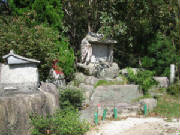
|
| Picture from: hiro731.web.infoseek.co.jp/ ohirayama/ohira.html |
| Nice, small little shrine made of painted wood. |
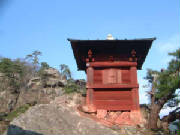
|
| Picture from: http://www.theorientalcaravan.com/index.html |
| Amusingly, a shrine to kitsune. |
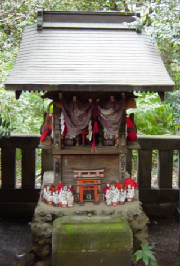
|
| Picture from: https://www.angelfire.com/wizard/lordhenry/ |
4. A Tale of Kitsune
I didn’t really make
this one up. ^_^ I retold it…with a few major differences. I first read a telling of the old Japanese tale from Mr.
Neil Gaiman—author of The Sandman: The Dream Hunters, as well as various
other works. He, in turn, read a telling of the tale called “The Fox, the Monk, and the Mikado of All Night’s
Dreaming.” The story can be found in the rev. B. W. Ashton’s Fairy Tales
of Old Japan.
I haven’t read Ashton’s
version. Gaiman’s is astoundingly good, and has beautiful pictures by one Yoshitaka Amano (known for his character designs
of Final Fantasy, among other things). If
you find Ashton’s version of the tale—please tell me, and I’ll politely ask you about the differences, similarities,
and possibly write you a present in return (…limit of 10 pages, please…).
Gaiman’s telling of the story
is longer than mine—and it’s more detailed, thusly. Also, try to read his version to get a concrete ending vs.
my “plot device” finale.
| Story by Gaiman, art by Yoshitaka |
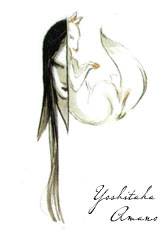
|
| The Sandman: The Dream Hunters |
| Gaiman's famous Dream...one of the Endless. |
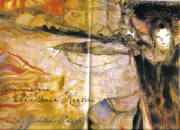
|
| The Dream King |
5. Kitsune (in general)
Foxes, alongside badgers/raccoons
and weasels, are known as trouble makers in Japan. They appear in many Japanese
stories—but unlike the Western counterpart, the fox isn’t always the bad guy.
I don’t know everything about
kitsune. Half of what I know I heard in Japanese—so I’m not too sure
I got the connotations down. I’ve also, like most of you, I’m sure, read manga and doujinshi with kitsune in the stories. I browsed on the internet a
little, and found out a few things… Namely, a kitsune can have many tails.
They serve Inari. They’re not really good or evil. They’re usually
black or white. The “leader” changes in mythologies—nothing’s concrete.
In any case, I tried to explain
my version of kitsune enough to get you through the story. I think I made a lot
up…*shrugs* but that’s more fun, isn’t it?
| I drew this silly, funny looking fox... |
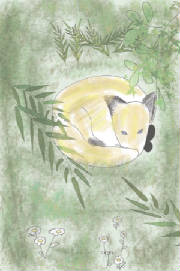
|
| ...don't steal him. He's trying to nap. |
6. The haiku by Issa.
I was really, really tempted
to be unprofessional and break the feel of the story by being spiteful. But I didn't. ^_^ ; barely.
In any case, the haiku is as follows:
At dawn
the homeless cat, too
cries for love.
有明や
家なし猫も
恋を鳴く
Ariyake ya
Ie nashi neko mo
koi wo naku
According to Haiku of Kobayashi Issa, this poem was written in 1809. The translation I used is © 2000-05 by David G. Lanoue, 'cause I figure he's got more practice
at translating haiku than me.
7. Japanese Sound Effects
I like sound effects. They illustrate
things really well, and add a cool little effect…but I translated them for you, ‘cause I don’t really know
most of those off the top of my head. Also, not all of them are Japanese. *Holds up artistic license* some of them are from
my head.
8. Sign of the top of the mountain.
I think most mountains have these…I
don’t really remember what they look like…so it might be a bit of artistic license again for a white toori to
be there. ^_^ ; (Toori, by the way, are red gates that mark the entrance to a holly area).
| The toori that marks Miyajima shrine. |
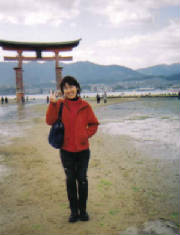
|
| Taise's host sister, Saori. |
9. Pictures of Mountain Climbing and
a view from the top of a mountain
Taise took these. They're really cool. The mountain being climbed is Sanbe...(Sanbe-san).
The mountain-top from which a picture was taken is called "Gokurakuji." Which translates to "Heavenly Temple" which is a "completely
wrong name, 'cause it was steep and therefore not heavenly at all." Taise complains with a laugh. Yeah. What you're
looking down at is...ehhh, he can't remember. It's near his school (Sanyou). ^_^ It's either in Hatsukaichi or whatever-city-Sanyou-is-in.
"I just rode my bike there. I don't know what city it's in..." he babbles. "I'm not even sure if it is in another
city."
...mountain climbing. It's basically walking up a really steep hill. ^_^ and you
still get tired...the boys will get cold a the top-- they should have brought a jersey and long sleeves...mountains (seriously)
are cold on top. ^_^
| Walking around Sanbe. |
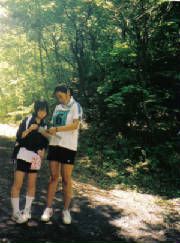
|
| Not actually on the mountain. (c) Taise |
| View of Hiroshima (not all of it) from Gokurakuji. |
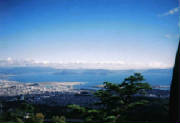
|
| (c) Taise. |
| Climbing Sanbe |
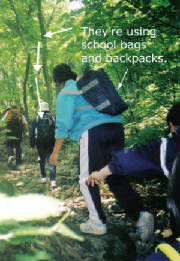
|
| (c) Taise |
| This is Sanbe. Don't ask me from where...ask Taise |
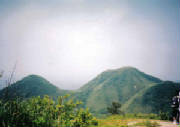
|
| (c) Taise |
10. The color white
Flowers...I need to ask about white flowers, too...
This is just an assumption. I'm going off of what I remember, what I think I've heard, and other things-- no concrete
evidence, really.
White in Japanese mythology is associated with death. Purity-- not so much, though. And only recently was the color white
adopted as the color for wedding kimono (I think they were copying western traditions with a Japanese twist).
Back to Chapter Six
|



